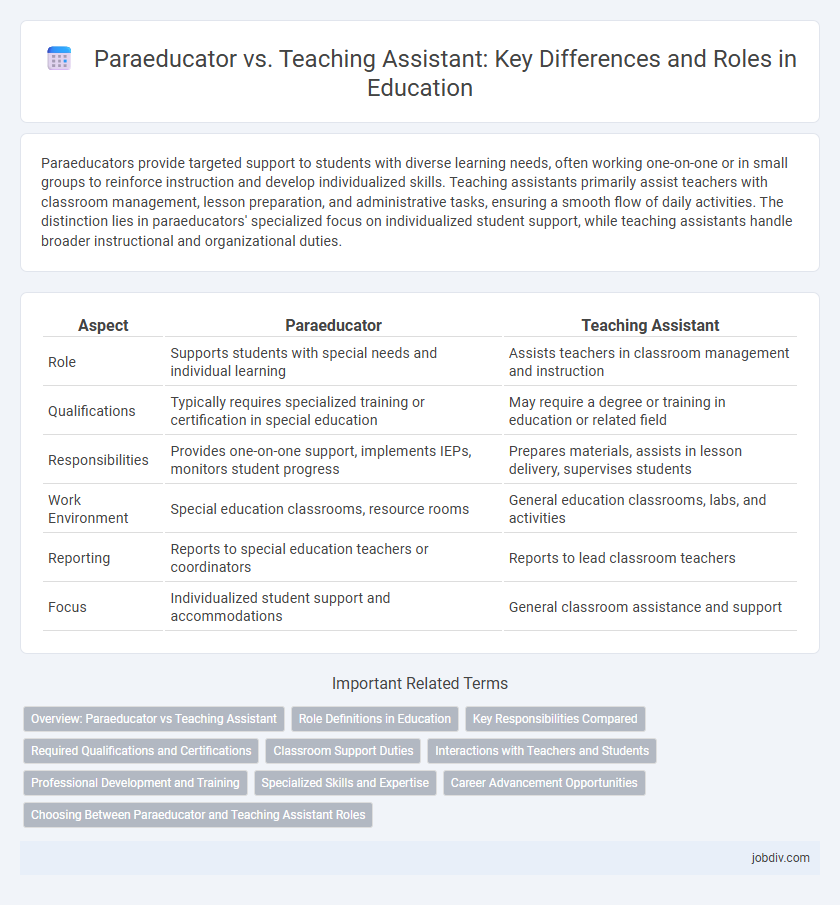Paraeducators provide targeted support to students with diverse learning needs, often working one-on-one or in small groups to reinforce instruction and develop individualized skills. Teaching assistants primarily assist teachers with classroom management, lesson preparation, and administrative tasks, ensuring a smooth flow of daily activities. The distinction lies in paraeducators' specialized focus on individualized student support, while teaching assistants handle broader instructional and organizational duties.
Table of Comparison
| Aspect | Paraeducator | Teaching Assistant |
|---|---|---|
| Role | Supports students with special needs and individual learning | Assists teachers in classroom management and instruction |
| Qualifications | Typically requires specialized training or certification in special education | May require a degree or training in education or related field |
| Responsibilities | Provides one-on-one support, implements IEPs, monitors student progress | Prepares materials, assists in lesson delivery, supervises students |
| Work Environment | Special education classrooms, resource rooms | General education classrooms, labs, and activities |
| Reporting | Reports to special education teachers or coordinators | Reports to lead classroom teachers |
| Focus | Individualized student support and accommodations | General classroom assistance and support |
Overview: Paraeducator vs Teaching Assistant
Paraeducators provide targeted instructional support and assist with classroom management under the direct supervision of certified teachers, often working with students who require specialized help. Teaching assistants perform a broader range of tasks, including administrative duties, lesson preparation, and general student support, contributing to the overall classroom environment. Both roles are essential for fostering student learning, but paraeducators typically focus more on individualized student needs while teaching assistants maintain wider classroom responsibilities.
Role Definitions in Education
Paraeducators support classroom teachers by providing targeted instructional assistance and helping manage student behavior, often working with students who have special needs or require additional academic support. Teaching assistants primarily focus on administrative and logistical tasks such as preparing materials, supervising students, and assisting with classroom organization, enabling teachers to concentrate on lesson delivery. Both roles are essential in fostering an inclusive and efficient learning environment, but paraeducators typically engage more directly in educational interventions.
Key Responsibilities Compared
Paraeducators primarily provide individualized support to students with special needs, assisting with behavior management and adapting instructional materials, while teaching assistants focus more on general classroom support such as preparing materials and helping lead group activities. Paraeducators often work closely with special education teachers to implement individualized education plans (IEPs), whereas teaching assistants support broader instructional goals across various subjects. Both roles require collaboration with lead teachers but differ significantly in their scope of student engagement and specialized responsibilities.
Required Qualifications and Certifications
Paraeducators typically require a high school diploma or equivalent, with many positions favoring candidates who have completed postsecondary coursework in education or child development. Teaching assistants often need more formal education, such as an associate degree or certification in education, along with state-specific licensure or training programs to meet regulatory standards. Both roles benefit from First Aid and CPR certifications, while some districts require specialized certifications for working with students with disabilities or limited English proficiency.
Classroom Support Duties
Paraeducators provide individualized instructional support by reinforcing lesson plans and assisting students with special needs, ensuring inclusive learning environments. Teaching assistants primarily handle classroom management tasks such as organizing materials, supervising students during activities, and supporting lead teachers in administrative duties. Both roles contribute to effective classroom operations but differ in their focus on direct instructional support versus organizational assistance.
Interactions with Teachers and Students
Paraeducators collaborate closely with teachers, supporting instructional delivery and adapting lessons to meet diverse student needs, while fostering a positive learning environment. Teaching assistants primarily assist with classroom management and individualized student support, often reinforcing teacher-led instructions through one-on-one or small group interactions. Both roles enhance educational outcomes by promoting engagement and providing targeted assistance to students under the guidance of licensed educators.
Professional Development and Training
Paraeducators typically receive targeted professional development focused on supporting students with special needs and implementing individualized education programs (IEPs). Teaching Assistants often undergo broader training encompassing classroom management, lesson preparation, and general instructional support skills. Both roles require continuous training to enhance their effectiveness, but paraeducators usually engage in more specialized workshops and certifications related to special education.
Specialized Skills and Expertise
Paraeducators possess specialized skills in supporting students with diverse learning needs, including expertise in behavioral interventions and individualized education plans (IEPs). Teaching assistants typically focus on general classroom support, assisting with lesson preparation and student supervision without requiring in-depth pedagogical training. The distinct expertise of paraeducators enhances tailored educational experiences for students with disabilities, while teaching assistants provide essential broad-based assistance in the classroom setting.
Career Advancement Opportunities
Paraeducators often have broader responsibilities and specialized training that can lead to career advancement into roles such as special education teachers or instructional coordinators. Teaching assistants typically support lead teachers and may pursue further certifications or degrees to transition into full teaching positions. Both roles provide foundational experience in educational settings that are valuable for advancing within school systems or obtaining administrative positions.
Choosing Between Paraeducator and Teaching Assistant Roles
When choosing between paraeducator and teaching assistant roles, consider the level of responsibility and qualifications required, as paraeducators often have more specialized training and work closely with students with disabilities, while teaching assistants support general classroom activities. Employment settings vary, with paraeducators primarily found in special education environments and teaching assistants commonly employed in regular classrooms. Understanding job descriptions, certification requirements, and career goals helps in making an informed decision between these educational support roles.
Paraeducator vs Teaching Assistant Infographic

 jobdiv.com
jobdiv.com